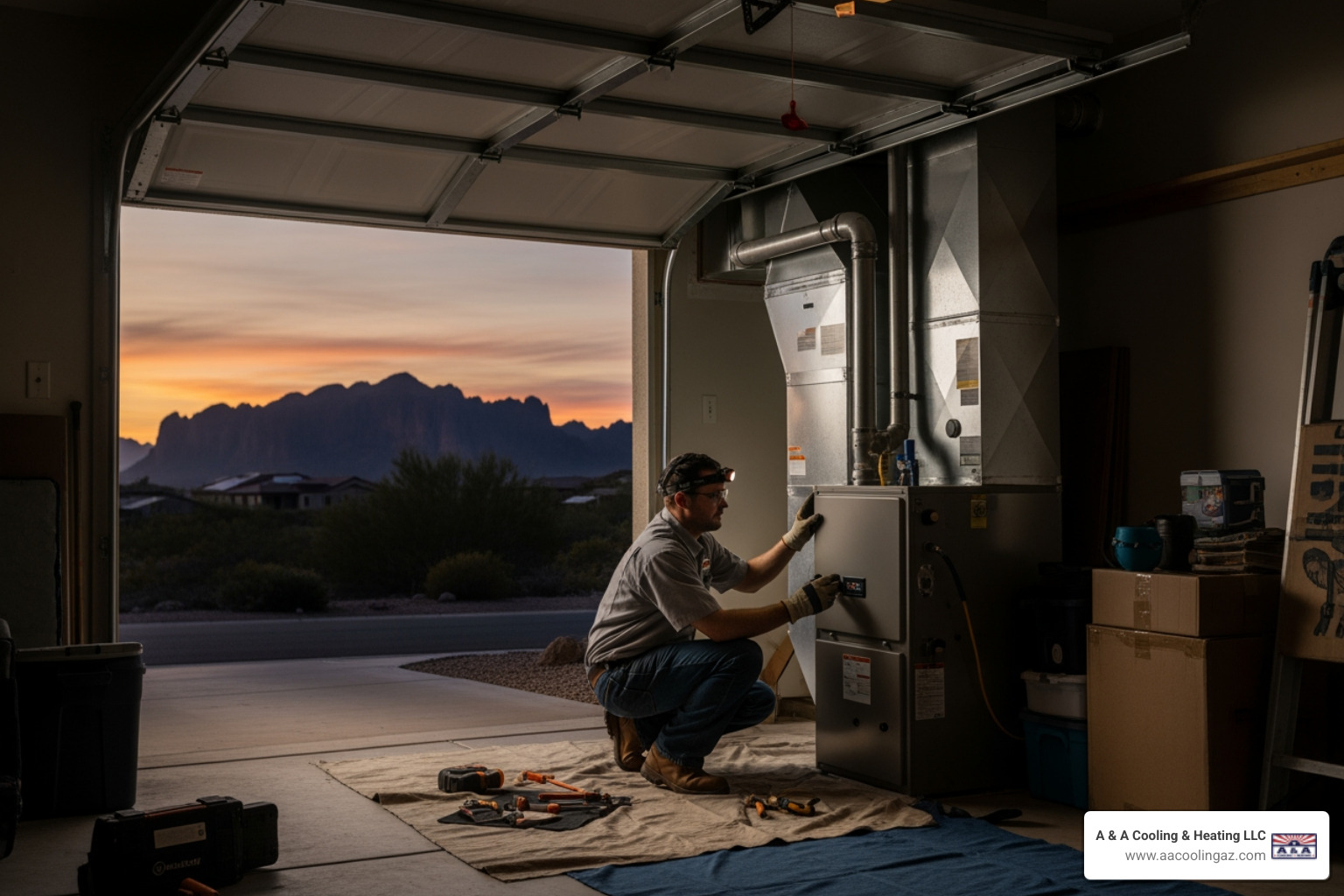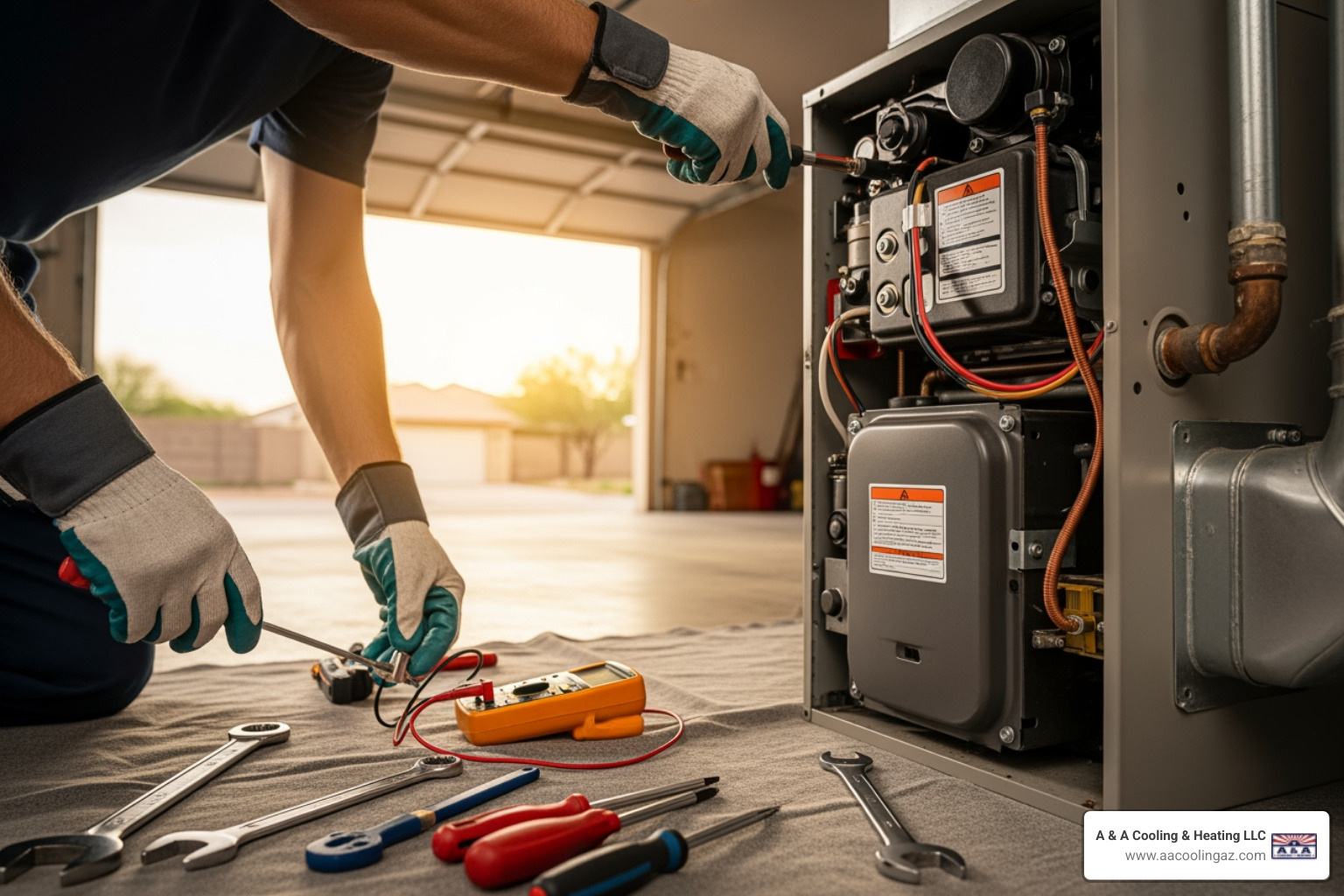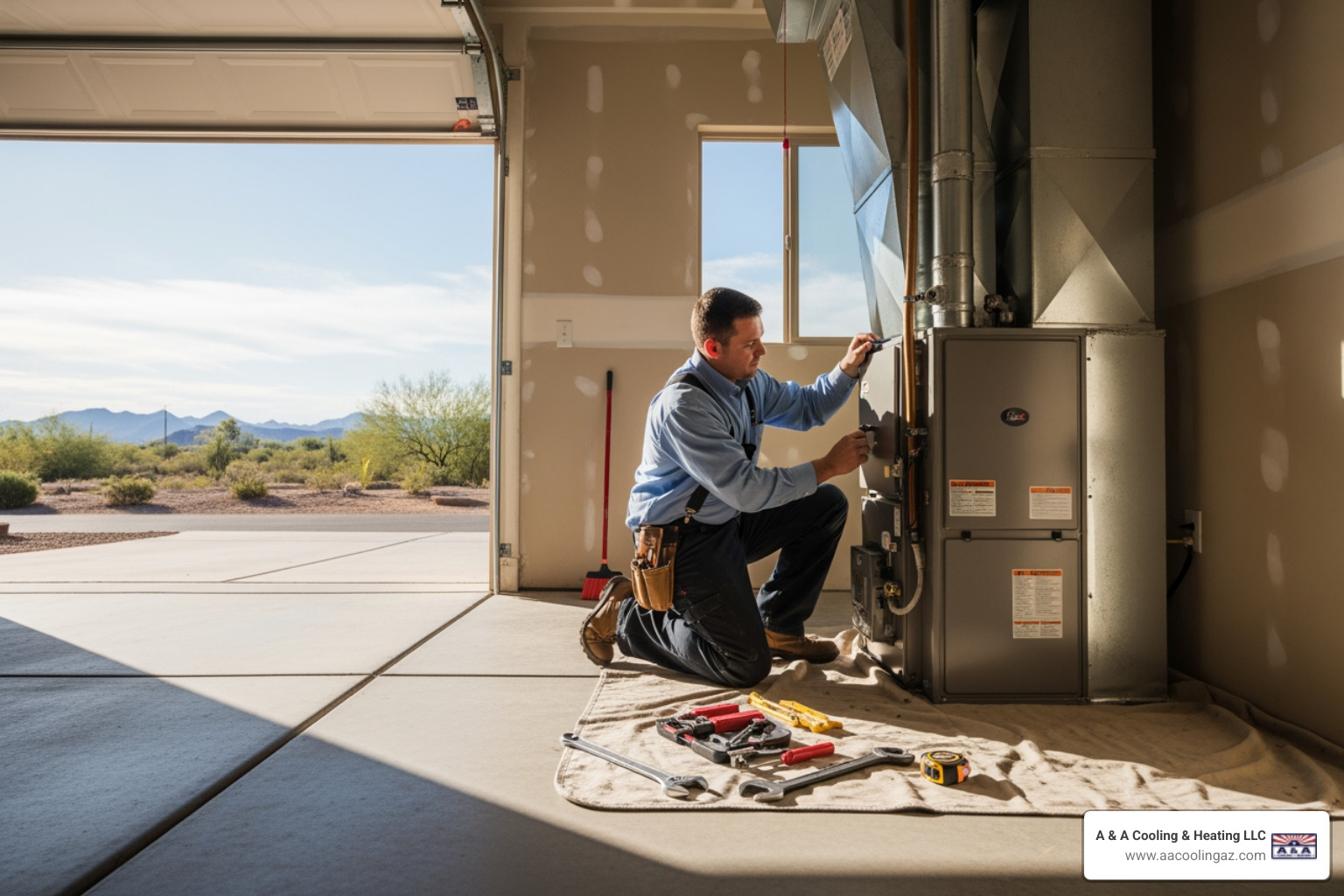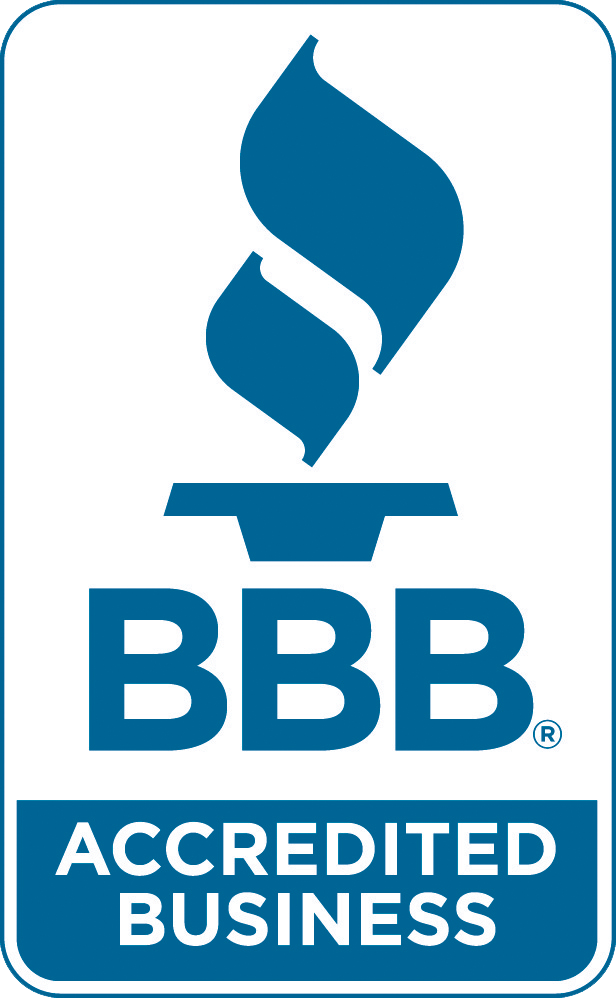Heat Pump Emergency Heat Mode Problems in Sun Lakes

When temperatures spike in Sun Lakes and your heat pump stops working the way it should, it can lead to a lot of discomfort. Most homeowners expect their heat pumps to run quietly and reliably, but when anything unusual starts happening, it’s important to know how your system is supposed to work. One critical function is emergency heat mode, which most people don’t think about until something goes wrong with it.
Emergency heat mode is designed to act as a backup heating method when the primary heat pump function can’t keep up. If it kicks on unexpectedly, or worse, doesn’t turn on at all when it should, it can leave you with cold spots, rising energy bills, or complete loss of heating. Understanding how this system works and what can go wrong with it helps prevent sudden breakdowns and keeps your home safe and comfortable.
What Is Emergency Heat Mode?
Emergency heat mode, sometimes called auxiliary heat, is a secondary heating method used in heat pump systems. It is not part of regular heating operation. Instead, it is designed to take over when the outdoor unit freezes, breaks down, or the heat pump can’t deliver enough heat on its own. Emergency mode typically activates through electric resistance heat, which uses more energy but can still warm the home when the main unit fails.
This function may kick in automatically when temperatures drop and the system detects it is unable to meet the indoor temperature setting. In some systems, it can also be manually turned on using the thermostat. When it runs correctly, it helps prevent freezing indoor conditions and keeps things livable while the primary unit needs inspection or repair.
In rare cases, it may come on even if it is not necessary, which leads to high power usage. On the other hand, if it fails to start when it needs to, you could find your home no warmer than the outside. Many homeowners in Sun Lakes don’t realize there’s a problem until they feel the chill inside and nothing seems to help.
Common Problems With Emergency Heat Mode
Many heat pump owners aren’t familiar with the signs that point to problems with emergency heat mode. When operating normally, the mode only functions when necessary and should keep the home warm without major fluctuations. But there are a few common issues that often affect this feature.
1. The system won’t switch to emergency mode. This can happen when the thermostat doesn’t sense outdoor unit failure correctly or cannot signal the backup heat to turn on.
2. Higher-than-normal energy usage. If you notice a sudden spike in your energy bill, emergency mode might be running when it shouldn't. Since it relies on electricity or other backup sources instead of the efficiency of the outdoor unit, extended operation leads to bigger utility costs.
3. Uneven or inconsistent heating. If some rooms are warmer than others, or you feel warm air followed by cool air in the same cycle, it could indicate the backup heat is short cycling or not fully engaging.
Outside of these, it is helpful to look for other signs:
- A constant red indicator light on the thermostat, which may be labeled EM HEAT
- The indoor air seems warm but quickly cools again without reaching the set temperature
- The outdoor unit is completely quiet, even though the thermostat is set to heat
- A burning smell once emergency mode turns on, possibly due to long periods of inactivity or dust buildup on internal components
One homeowner in Sun Lakes shared how their system stopped producing enough heat during an unexpected cold snap. They assumed the thermostat was just set incorrectly, but after some time, it was clear something wasn’t switching over. Once checked, it turned out the emergency heat mode had failed to activate due to a wiring issue in the thermostat, leaving them without backup heating until it was fixed.
These types of issues aren’t always obvious at first glance. That’s why it is important to know what the signals look like and act early instead of waiting for the system to fail entirely.
Causes of Emergency Heat Mode Issues
Several factors can disrupt how emergency heat mode functions in a heat pump system. While some issues develop over time due to wear, others can appear suddenly due to component failure or external conditions. Understanding the causes helps pinpoint the problem quicker and reduce the chances of the system breaking down during the hottest or coldest days in Sun Lakes.
One of the most common causes is a thermostat malfunction. If the thermostat doesn't properly detect changes in temperature or can’t register when the outdoor unit isn’t working, it may fail to activate the emergency mode. Wiring issues, sensor errors, or software glitches in smart thermostats can lead to miscommunication between the thermostat and the HVAC system.
Electrical problems are another leading cause. Breakers might trip, wiring may become loose, or relays could stop responding. Since emergency heat often relies on electric resistance coils, reliable electrical flow is needed for this mode to work. Power supply instability, even momentary, can prevent your system from switching over when needed.
General wear and tear on system components also plays a part. Backup heating elements don’t operate often, which means they can sit unused for long stretches. When activated without warning, these parts may fail due to corrosion, dust buildup, or part degradation. Without regular maintenance, these small issues go unnoticed until heat is required quickly.
Weather in Sun Lakes can also stress HVAC systems. Long periods of high heat in summer can cause deterioration to electrical panels and connections, while sudden cold spells may force systems to switch functions unexpectedly. If insulation around wires or terminals gets worn from heat exposure, or outdoor units suffer weather-related wear, it makes the transition to emergency mode less reliable.
Why Professional Solutions Matter
When something feels off with your heat pump’s emergency mode, pushing buttons or guessing rarely helps and can make things worse. Hiring our professionals for diagnostics brings a level of expertise and accuracy that prevents damage and avoids wasted time. These issues often involve hard-to-find component failures or alignment problems within the system’s programming.
Our technicians do more than replace parts. They check compatibility, update settings, clean contacts, and test each stage of heating to get the whole system balanced again. That’s important during extreme weather, when backup functions need to work immediately. If a thermostat is misreading or an electric heater fails calibration, our team can replace or recalibrate those parts safely.
Beyond repair, we run full performance tests to ensure proper cycling. Emergency heat shouldn't run longer than needed, and systems that run too often signal deeper issues. Regular service visits also uncover problems early. When caught in routine inspections, these problems are usually smaller, less costly, and easier to fix.
Preventive Steps for Reliable Operation
Catching problems early reduces strain and lowers the chance of complete failure. Most emergency mode issues start small and grow if left unchecked. Staying ahead of them means checking key parts and watching for sudden changes in performance. Reducing your risk of failure starts with a simple routine.
Here are action steps for homeowners in Sun Lakes:
- Schedule professional maintenance yearly before seasonal temperature shifts
- Learn how your thermostat operates, especially how and when to activate emergency heat
- Replace thermostat batteries at least once per year to avoid power loss
- Keep outdoor HVAC units clean and inspect them for visible damage
- Monitor energy bills and take note of unexpected increases
- Report cold spots, inconsistent temperatures, or odd smells right away
Many homeowners in Sun Lakes assume their system isn’t used as hard due to milder winters, but minor malfunctions in rarely used emergency components can go undetected for years. Then when sudden need arises, like during a cooler-than-normal evening, the system fails to respond. That’s why checking these parts even when they’re not in active use is still worthwhile.
Ensuring Heat Pump Performance in Sun Lakes
Emergency heat mode plays a critical role in your system’s readiness. It might not run often, but it needs to work when it does. Catching small issues before they grow and letting our professionals handle repairs protects your comfort and helps control long-term operating costs.
Living in Sun Lakes means dealing with rising summer heat and occasional cold periods that catch systems off guard. Making sure your heat pump runs as it should, including its emergency functions, helps avoid surprise breakdowns. Systems tuned properly survive seasonal changes better and provide peace of mind. Don’t wait for an outage to take action. Keep your system reliable all year long.
If your heat pump’s emergency mode is causing inconsistent heating or increased energy bills, A & A Cooling & Heating LLC is here to help. With expert diagnostics and dependable heat pump service in Sun Lakes, our technicians work to restore full system performance and ensure comfort throughout your home. For a quick estimate or to book a service visit, please contact us today.



















